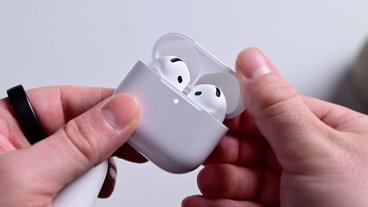The team behind popular benchmarking suite Geekbench has rounded up the scores for Apple's newest Retina MacBook Pro models and finds that despite slower processor clock speeds across the board, the Haswell-powered laptops outperform their predecessors by as much as 8 percent.
Apple's newest high-end 15-inch Retina MacBook Pro shows significant performance gains over its predecessor
Single-core performance for the 13-inch variants is up only two to four percent over the previous generation, which John Poole, founder of Geekbench parent Primate Labs attributes to the new revision's focus on power efficiency rather than speed gains.
The 15-inch variant sees much larger leaps in performance in its high-end configuration — the newest 2.6-gigahertz flagship jumps eight percent in both the single and multi-core benchmarks over its 2.8 gigahertz predecessor, for example. Mid and low-end variants gain a more pedestrian two to four percent.
Interestingly, the latest high-end 13-inch MacBook Air trails the new 13-inch MacBook Pro by only five percent in the single-core benchmark, though the gap widens to thirteen percent in the multi-core benchmark. "Users with applications that only use one core won't notice much difference between the Air and the Pro," Poole writes. That does not extend to the laptops' battery life, however, as the MacBook Air still bests the new MacBook Pro by three hours in that category.
Poole calls the performance increases from the more conservatively-clocked Haswell processors "interesting," but notes that the processors are not always running at the advertised speeds. Thanks to Intel's Turbo Boost feature, the clock speeds can be increased as needed to handle more demanding workloads — the 2.3-gigahertz Haswell chip in the newest MacBook Pro can boost up to 3.5 gigahertz, for example.
The Geekbench scores, which began trickling in on Wednesday, are based on processor and memory performance. GPU performance is not included, and as a result we have yet to see what effect the inclusion of Intel's Iris Pro graphics chip has on the Retina MacBook Pro's capabilities.
 Shane Cole
Shane Cole








 Thomas Sibilly
Thomas Sibilly
 Wesley Hilliard
Wesley Hilliard
 Marko Zivkovic
Marko Zivkovic

 Malcolm Owen
Malcolm Owen

 Amber Neely
Amber Neely









30 Comments
I would like to know why rMBP only has an additional hour of battery life when the CPU is turned down and Mavericks is suppose to bring big battery savings, and the entry 15" has integrated graphics.
What else changed that all these battery saving technologies only gained an hour, when the MBA gained so much more, and then an additional hour with Mavericks. Somethings seems off.
[quote]Thanks to Intel's Turbo Boost feature, the clock speeds can be increased as needed to handle more demanding workloads %u2014 the 2.3-gigahertz Haswell chip in the newest MacBook Pro can boost up to 3.5 gigahertz, for example. [/quote] And how is this different than Sammy's "benchmark booster" for which we gleefully derided the company?
[quote name="TeaEarleGreyHot" url="/t/160363/apples-new-retina-macbook-pros-bring-faster-benchmarks-with-slower-clock-speeds#post_2424231"] And how is this different than Sammy's "benchmark booster" for which we gleefully derided the company?[/quote] The Intel Turbo feature is available to every application, not just benchmarks.
OK, Jean Luc, let me explain...
Samsung's "benchmark booster" feature specified certain applications under which it would "increase performance output", with those applications specifically
named being "benchmarking apps". The rest of the time, it does little "when needed", as those performance boosts significantly degrade battery life to the point of seriously degrading product desirability.
Intel's "burst mode" appears at any time it's needed or requested, and is application-name agnostic. Because it operates efficiently, unless you're doing things like grinding heavy HD video edits in Final Cut while in the field, you won't see substantially degraded battery life, even with that kicking in from time to time as it's designed to.
In other words, one is marketing hype (and only really used when needed to make the company/product look better) and the other is an actual performance/efficiency enhancement.
Get the difference?
And how is this different than Sammy's "benchmark booster" for which we gleefully derided the company? I will assume you are asking a serious question. Because the Turbo Boost feature is available to all software and therefore is a reasonable tool to use for benchmarking. Sammy's boosted their speed beyond that available to any apps except for the benchmarks. Therefore - they are lying.